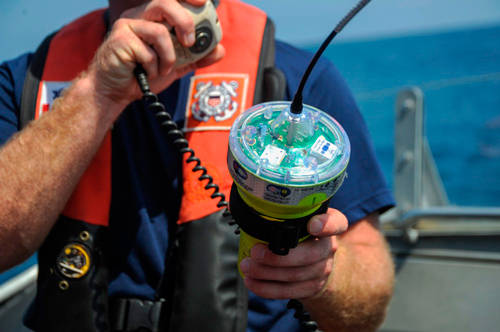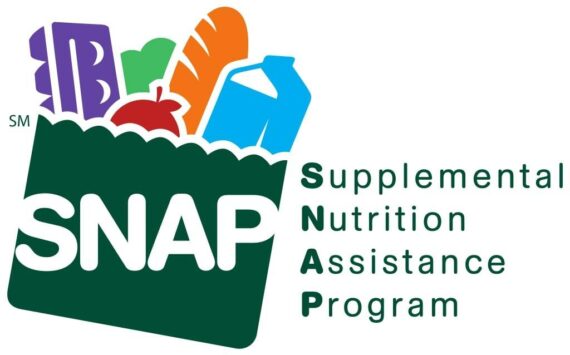Coast Guard urges boaters to register EPIRBs, file float plans
SEATTLE – Every year the Coast Guard makes thousands of phone calls to mariners, boat owners and emergency points of contact in response to receiving distress alerts from emergency position indicating radio beacons.
An EPIRB is a beacon that alerts the Coast Guard that the vessel registered to the EPIRB is in distress and requires a search and rescue response. These alerts can often mean the difference between the life and death of persons on the water and have been critical to providing rescue teams with the necessary information to quickly and effectively respond.
How does an EPIRB work? These devices can be activated either manually or automatically when submerged in water. Once activated, the device will release a signal that is picked up by a satellite and transferred to the nearest receiving Land User Terminal. The land terminal forwards the signal to the United States Mission Control Center, which then passes the information to the applicable Coast Guard District for response action. Once received, the Coast Guard activates the Search and Rescue system and uses the beacon registration information and the position provided from the satellite to coordinate response. One of the most effective means to locate the vessels and persons in distress is by calling individuals associated with the beacon’s registration – which may be you!
If you are receiving a call from the Coast Guard about an EPIRB alert, it is likely that you are listed as a point of contact or emergency point of contact on the beacon registration. When receiving this call, it is important to note that the vessel may or may not be in distress, but more information is needed to verify. Some alerts are released in error; however, the Coast Guard responds to each alert as an actual distress until it can be confirmed otherwise.
In some cases, a position is not obtained by the satellite, leaving search and rescue authorities with only the beacon’s registration information to determine a vessel’s location and distress situation. Out of date, or improperly registered beacons, can make locating the vessel in distress difficult and impede the response time of search and rescue teams. It is of critical importance that owners update beacon registration when acquiring a new vessel, when point of contact information changes, or, at a minimum, every two years as required by the National Oceanic and Atmospheric Administration. In addition to having an up to date EPIRB, it is always best practice to leave a float plan detailing your voyage intentions, whether short or long, with a friend or emergency contact.
“While we don’t keep float plans for you, we do recommend that you keep your loved ones informed, especially if they are a part of your EPIRB registration,” said Scott Giard, Search and Rescue Program Manager for the 13th Coast Guard District. “If your family can confirm that you are underway and can provide a general location, it helps our crews get to you that much faster if you are in actual distress.”
The Coast Guard has a boating safety app available at https://uscgboating.org/mobile/, which features a virtual float plan that can be emailed to anyone the boater chooses.
For more information about EPIRBs and registration questions, please visit NOAA’s Search and Rescue Satellite Aided Tracking website at https://www.sarsat.noaa.gov/faq%202.html. To register your EPIRB, visit http://www.beaconregistration.noaa.gov and select Register Your Beacon. There, you can update your beacon registration, report if it is lost or stolen, learn to properly dispose your old beacons and batteries, correctly test you 406 MHz beacon, and more.
Coast Guard MFPU Bangor, WA, transfers command
SILVERDALE, Wash. — Cmdr. Matthew A. Michaelis relieved Cmdr. Thomas C. Evans as commanding officer of Coast Guard Maritime Force Protection Unit Bangor during a change of command ceremony held Friday at Naval Base Kitsap Bangor.
Rear Adm. Anthony “Jack” Vogt, commander, 13th Coast Guard District, presided over the ceremony.
Evans thanked the local community for the support given to the Coast Guard, particularly during last year’s partial government shutdown.
Evans also commended the dedicated men and women of MFPU Bangor for their hard work during his tenure as commanding officer and praised their resiliency during the current COVID-19 crisis.
Evans departs MFPU to join the staff at the 13th District in Seattle.
Michaelis comes to MFPU Bangor after completing his previous assignment as the chief of enforcement at the 13th District.
Everett-based Coast Guard Cutter Henry Blake receives new commanding officer
EVERETT, Wash. — The crew of the Coast Guard Cutter Henry Blake held a change of command ceremony Monday at Naval Station Everett.
During the traditional military ceremony, Lt. Myles McCarthy relieved Lt. Joshua Branthoover of command of the cutter Henry Blake under the direction of Rear Adm. Anthony “Jack” Vogt, commander, 13th Coast Guard District.
McCarthy is reporting to the Henry Blake from U.S. Coast Guard Academy, Maritime Studies Branch. Branthoover will be the new team supervisor at the United Kingdom Support Team.
The Henry Blake is the thirteenth of 14 Keeper-class of coastal buoy tenders. All the coastal buoy tenders are named after famous U.S. Lighthouse Keepers. Mr. Henry Blake was the first lighthouse keeper of the New Dungeness Light, which is located on the tip of the Dungeness Spit in the Strait of Juan de Fuca.
The cutter Henry Blake was constructed by Marinette Marine Corporation in Marinette, Wisconsin, and was commissioned on Oct. 27, 2000. Her primary mission is to ensure aids to navigation in the environmentally sensitive Puget Sound are maintained to the highest standards, therefore ensuring the safe navigation of the vessels which carry over $40 billion each year.
The crew of the Henry Blake has the primary responsibility for the maintenance of 177 buoys and 58 shore aids to navigation.
The change of command ceremony is a time-honored tradition and deeply rooted in Coast Guard and Naval history. The event signifies a total transfer of responsibility, authority and accountability for the command.
Coast Guard urges paddler safety this summer across PNW
SEATTLE — The Coast Guard urges the public to be prepared when operating a paddle craft on the water as summer kicks off across the Pacific Northwest.
As stay-at-home restrictions are eased and air temperatures rise, in our rush to get outside and enjoy the beautiful Pacific Northwest, it is easy to forget that water temperatures remain dangerously cold.
However, there are some easy steps that you can take to ensure your own safety while recreating on the water. In the U.S., an estimated 130 people die annually while kayaking or canoeing; 90% of those deaths as a result of drowning.
Factors that contributed most to these fatal accidents were: failure to wear a life jacket, operator inattention or inexperience, alcohol and drug use, hazardous waters, weather conditions, and navigation rule violations. Don’t forget: life jackets are required by law to be on all vessels, including kayaks, canoes and paddleboards.
Below are steps you can take to ensure a fun time out on the water and make it home safely.
File a ‘Float Plan’ – Before you leave, create a plan and let someone staying behind know your itinerary. The plan should include the contact information for all individuals going out, the intended route, and what to do in case of emergency or non-arrival at the estimated return time.
Check the weather – The weather can change quickly and is often a leading cause of getting into trouble. Prior to departure, check the weather for current and forecasted conditions. This should include understanding how different weather conditions, tides, and currents will affect your waterway and craft.
Wear a Coast Guard-approved personal floatation device – Personal Flotation Devices save lives, if they fit and you wear them. In many incidents, life jackets were onboard but not worn; and once you are in the water it may be too late to put one on or adjust it, as cold-water shock is a deadly and ever-present threat in the Pacific Northwest. A highly visible PFD, with reflective tape, will assist mariners in seeing an individual and increases the chances of being found by a search team if the need arises. To further reduce the risk of hypothermia and cold-water shock, it is advisable to dress to the water temperature – not the air temperature – by wearing a dry suit, wet suit, or other synthetic materials (not cotton).
Label your paddle craft – A label allows responders to confirm if someone is actually in trouble and collect information to help search efforts. A simple label with a name, contact information, and alternate contact number written in waterproof ink or paint can drastically reduce search times; in addition to ensuring the return of any wayward watercraft to its owner.
Go with a friend – Two people allow one to help the other in case of emergency, and allows for that critical call for help to initiate a search and rescue response if the need arises.
Waterproof communication devices – This could be something as simple as a whistle, air horn, or cell phone in a waterproof case, to flares, a handheld VHF radio, or a Personal Locator Beacon (PLB) with proper registration. These devices will allow you to alert mariners in the immediate vicinity or send an alert to the Coast Guard.
Avoid Alcohol and Drugs – Boating under the influence is ILLEGAL. This applies to all boats including kayaks, canoes, paddleboards, rowboats, and inflatable fishing rafts. The use of alcohol or drugs while operating any vessel is unsafe and impairs judgement, motor skills, situational awareness, and can hasten onset of hypothermia.
These simple steps can ensure you are prepared to enjoy the water safely and responsibly.
– United States Coast Guard





